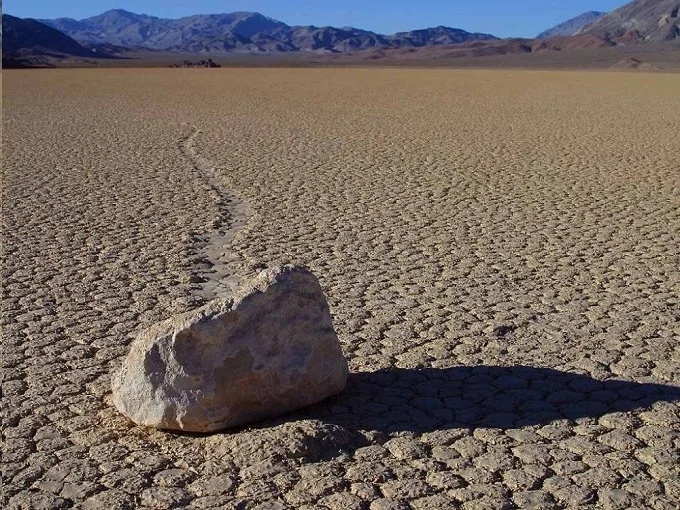Racetrack Death valley: Why do the rocks of Death Valley move?

A very old and popular mystery topic on the Internet is the Sailing Rocks of Death Valley. Well, you remember that this is a geological phenomenon discovered on the dry lake Racetrack Playa in Death Valley in the USA. But why do the rocks of Death Valley move?
The rocks move slowly along the clay bottom of the lake, as evidenced by the long tracks left behind them. The rocks move on their own without the help of living beings, but no one has ever seen or recorded the movement on camera. Rocks move only once every two or three years, and most of the traces remain for 3-4 years.
Until the beginning of the 20th century, the phenomenon was explained by supernatural forces, then during the formation of electromagnetism, an assumption arose about the effect of magnetic fields, which, in general, did not explain anything. Most hypotheses agreed that the wind at the wet surface of the lake bottom at least partly explains the phenomenon.
And in 2014, a work was published in the Public Scientific Library, the authors of which describe the mechanism of movement of rocks.

The fact is that not everyone knows that these rocks are located on a dried-up lake, which is sometimes flooded with water.
Therefore, scientists placed several of their rocks weighing 5-15 kg on the bottom of the lake, providing them with navigation sensors and surrounding them with cameras. The reason for the movement was large (tens of meters), but thin (3-6 mm) patches of ice formed after freezing during the preceding frosty nights. This floating ice, carried away by the wind and the under-ice current, moved rocks at a speed of 2–5 m/min.
In fairness, it should be noted that back in 1955, geologist George Stanley from the University of Michigan published an article in which he and his colleague proposed a theory according to which, during the seasonal flooding of a dried-up lake, an ice crust forms on the water, contributing to the movement of rocks.
In May 1972, Robert Sharp (Caltech) and Dwight Carey (UCLA) started a rock movement monitoring program. Thirty rocks with relatively recent footprints were marked and their location marked with pegs.
For 7 years, during which the position of the rocks was fixed, scientists created a model according to which, during the rainy season, water accumulates in the southern part of the lake, which spreads by the wind along the bottom of the dried lake, wetting its surface. As a result, hard clay soil becomes very wet, and the coefficient of friction drops sharply, which allows the wind to move even one of the largest rocks (it was called Karen), which weighed about 350 kilograms.
Hypotheses of movement with the help of ice were also tested. Water spreading under the influence of wind can become covered with an ice crust at night, and rocks located in the way of water will be frozen into the layer of ice. The ice around the rock could increase the cross-section of interaction with the wind and help move the rocks along with the water flows. As an experiment, a corral with a diameter of 1.7 m was created around a rock 7.5 cm wide and weighing 0.5 kg.
The distance between the fence supports varied from 64 to 76 cm. If a layer of ice formed around the rocks, then when moving, it could catch on the fence support and slow down the movement or change the trajectory, which would be reflected on the track from the rock.
However, no such effects were observed – in the first winter, the rock passed near the fence support, moving 8.5 m beyond the fenced area in the direction of the northwest. The next time, 2 heavier rocks were placed inside the pen – one of them moved in the same direction as the first five years later, but its companion did not budge during the period of research. This fact indicated that if the ice crust has an influence on the movement of rocks, then it must be small. Here you have a contradiction with the latest study of 2014!
Ten of the marked rocks moved during the first winter of the study, with rock A (called Mary Ann) crawling 64.5 m. It was noted that many rocks also moved in the next two winters, and in summer and other winters, the rocks stood still.
At the end of the study (after 7 years), only two of the 30 observed rocks did not change their location. The smallest of the rocks (Nancy) was 6.5 cm in diameter, and this rock moved a maximum total distance of 262 m and a maximum distance in one winter – 201 m. The most massive rock, the movement of which was recorded, weighed 36 kg.

In 1993, Paula Messina (California State University at San Jose) did her thesis on moving rocks, which showed that, in general, the rocks did not move in parallel. According to the researcher, this confirms that the ice does not contribute to movement in any way.
After studying the changes in the coordinates of 162 rocks (which were carried out using GPS), it was determined that neither their size nor their shape affects the movement of boulders. It turned out that the nature of the movement is largely determined by the position of the boulder on Racetrack Playa. According to the created model, the wind over the lake behaves very complexly, even forming a whirlwind in the center of the lake.
In 1995, a group led by Professor John Reid noted the high similarity of tracks from the winter of 1992-93 with tracks from the late 1980s. It has been shown that at least some of the rocks moved with currents of ice-covered water, with the width of the ice crust being about 800 m, as evidenced by characteristic traces scratched by a thin layer of ice. It was also determined that the boundary layer in which the wind slows down due to contact with the ground could be as small as 5 cm on such surfaces, which means that even very low rocks can be affected by winds (whose speed reaches 145 km / h in winter).
So there are probably several reasons why rocks can move, and they can act simultaneously. But it’s definitely not magic.




